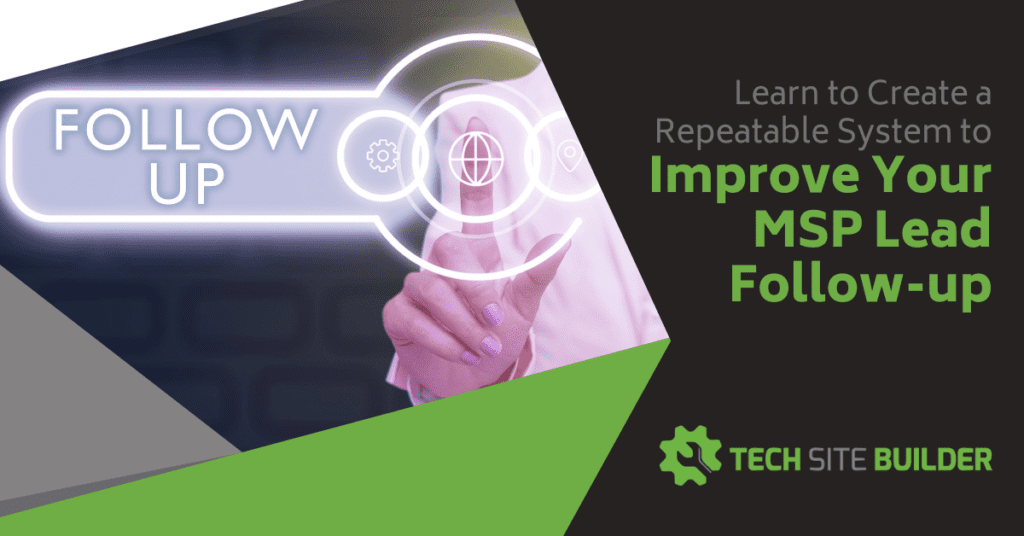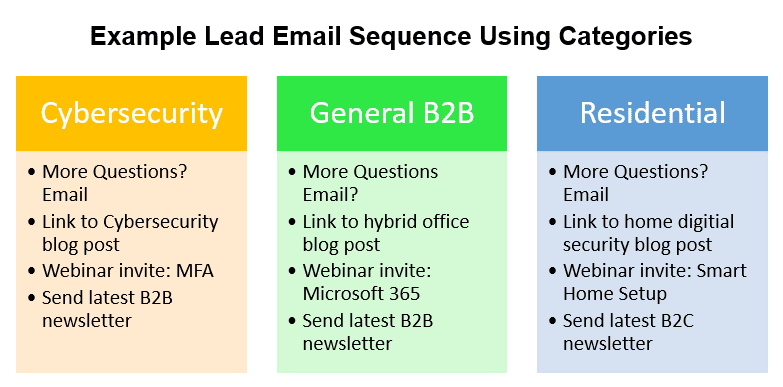
How many of your leads end up converting to sales? For many IT business owners, it’s not enough. They work to get leads but can’t crack the code on getting more to convert to customers.
An inconsistent lead follow-up process might be to blame, along with a lack of follow-up finesse. This includes sending leads the right content at the right time, but not overwhelming them.
In this article, I’ll go through how to create a repeatable system that can help you convert more leads and take less time doing it.
Use a Process to Improve Your Results
Think about how you follow up with leads right now. Do you take the same steps with all of them? Or is it more hit-or-miss?
Some MSP business owners will do an excellent job at follow-up when they have the time. They’ll call the lead, send them information targeted to their needs, then tag them for an email follow-up a week or so later.
But what happens when that business owner gets busy? Then, following up with leads takes a back seat. Another lead might get the bare minimum, an answer to their initial inquiry, and that’s it.
Inconsistent follow-up will lead to inconsistent results. It’s also impossible for you to analyze and tweak your follow-up process if it’s not being applied to all leads in the same way. How can you know what’s working and not working?
The truth is that most salespeople stop short of the necessary number of “touches” with a lead. According to WordStream, 80% of sales happen only after five follow-ups with the contact. But many salespeople give up too soon.
Average follow-up numbers for salespeople:
- 44% stop after one rejection
- 22% stop after two rejections
- 14% stop after three rejections
- 12% stop after four rejections
- 8% will continue after five rejections
But wait, does that mean I have to bug someone non-stop just to get the sale?
No, not at all. No one wants to be stalked by a salesperson, and most MSP business owners don’t have the time for that and aren’t comfortable with it anyhow.
The secret is to use forms of follow-up that are helpful and don’t always include an in-person interaction. Focus on being helpful, and you can’t go wrong.
Here are some key elements of a repeatable lead follow-up system.
Decide on Your Number of “Touches”
Each follow-up you do can be considered a touch. You’re touching the client in some way with a message. Before you can put a process in place for every lead, you need to decide on the number of follow-ups to use.
A good number to start with is somewhere between 5 to 7 distinct follow-ups. If the person signs up for your email newsletter, then they can continue to get those touches each month until they unsubscribe.
Vary Your Message Delivery
When you first receive a lead that is asking a question or showing interest in your content (such as downloading an eBook), you want to strike while the iron is hot.
For this first follow-up, it makes sense to reach out with a call or email for direct person-to-person contact.
But for your subsequent follow-ups, vary how you reach out. For example, if the person signed up for your newsletter, send them the latest one. Reach out and connect on LinkedIn, without giving them a sales pitch. You can also wait a couple of weeks and send an invitation to your next webinar on cybersecurity.
The point is to vary the types of follow-ups you do. This keeps the lead from feeling stalked or pressured. Instead, you’re reaching out with helpful, light touches and just letting them know you’re there to help.
Automate What You Can
To keep your follow-up process consistent no matter how busy you and your team are, you need to automate what you can.
For example, use an email sequence set up in an app like MailChimp or MailerLite to automate your follow-ups for you. All you need to do is add the lead to the sequence, and it’s all taken care of from there.
Of course, mix in personal follow-ups as needed. For example, when answering an initial or subsequent question from the lead.
Keep Messages Short & Friendly
How can you follow up multiple times without sounding pushy? Keep messages short and friendly. For example, when sending your latest blog post that’s relevant to the person’s IT needs, use a message like, “Hi Joe, thought you might find this article on productivity apps helpful.”
When the message is inviting and friendly, instead of being a sales pitch every time, you build a relationship of trust. The person knows that they don’t have to try to avoid you because you’re not going to be coming at them like a used car salesman.

Analyze & Optimize Your System
Once you put your lead follow-up process in place, use it with every lead for about 6-8 weeks, then analyze the results. Look for areas in the sales pipeline that can be tweaked or leveraged.
Here are some things to look for:
- Is there a particular step when they stopped responding?
- Did a certain message trigger a sale or another question?
- Do leads mention a particular thing being helpful to them (a blog post article, newsletter tip, etc.)?
- How many touches on average does it take your leads to convert?
Having a repeatable process in place, allows you to analyze these things so you can further enhance your lead conversion results.
Sample Lead Follow-up Template You Can Use
So, where do you start?
Below, I have a sample lead follow-up template that you can use to kick off your own strategy. Of course, this should be tailored to your target audiences and needs.
Also, I should call out that any time a lead responds directly, you should pause the lead sequence, and connect with them personally to answer a question or provide a quote. Then, if the lead hasn’t converted, you can resume your follow-up sequence.
This should be fluid and tailored to the lead as much as possible. Once the lead converts, you can move them to your customer welcome process, which can include things like sending a thank you card, requesting a review, etc.
Remember, you can put most of these follow-ups in an automated sequence to save time and ensure they go out on schedule.
Day 1: Initial Personal Phone Call or Email
When you first receive a lead, you want to introduce yourself and answer any questions they’ve posed. If they have provided a phone number, give them a call.
If you can’t reach them by phone or they haven’t provided a number, then follow up with a personal email addressing their interest in your IT services.
Day 2 or 3: Email to Ask If Questions Were Answered
About 24-48 hours after your first interaction, send an email to ask if they had their questions answered, or if they have any other questions that you can assist them with.
This serves two purposes:
- As your next “touch” and reminder that you’re still there to help
- To make sure they received your first response. If it went to spam, they may think you never responded initially at all.
Day 5: Email a Blog Post Topic of Interest
Next, email them a link to one of your blog posts that has a topic of interest to them. This shouldn’t include any type of sales pitch, just something simple like, “I thought you might find this information useful.” Then, add the link.
How do you personalize the topic of interest, while also automating the process? You categorize your leads when you first drop them into the follow-up email sequence.
For example, make 2-3 categories in your email program that match your target audiences. This could be something like “Cybersecurity, General B2B, Residential.”
This allows you to add some targeted messages without having to do each email manually. You can easily edit your email template in the sequence to freshen up the content link as needed.

Day 7: Connect with Them on LinkedIn
This next touch is a very light one, you simply send a connection request on LinkedIn, and if they have a company page, follow that as well.
Don’t put a sales pitch in your connection request, a simple, “Hi, reaching out to connect.” is enough. If you try to turn it into a sales pitch, they’ll likely ignore your request and get a negative vibe. Your goal is to make it a positive experience. Reach out as another business owner/business professional, not as a salesperson.
They’ll be reminded that you’re still there and ready to help when needed.
Day 14: Invite Them to a Webinar or Your Video Channel
If you host ongoing technology webinars, send an invitation to the next one in this follow-up email. If you have a pre-recorded webinar or a video channel of tips, you can send a link to that instead.
Static videos don’t give you the same personal interaction as a live webinar with Q&A does. But on the plus side, they are easier to fit into a busy schedule because they can be watched on demand.
People favor videos over all other types of content when seeking out information from a company. 96% of consumers seek out videos to learn more about a product or service.
Need help getting a webinar started? Check out: “Generate Sales for Your IT Business by Hosting an Awesome Webinar.”
Day 21: Send Your Latest Email Newsletter & Invitation to Subscribe
If the lead hasn’t yet signed up for your email newsletter, you want to invite them to subscribe. This is your way of transitioning someone who hasn’t converted yet from active follow-up to more passive follow-up.
Getting an email from you once per month will remind them of your products and services. I’ve seen people convert after receiving newsletters for 6-months, saying they appreciated the helpful content.
If you can get someone on your newsletter subscription list, you have a better chance of being at the top of their mind when they are ready to move forward with a purchase.
Follow-Up Is More Effective When You Have a Process
Putting a repeatable process in place for lead follow-ups can produce more conversions without taking up a lot of your time.
Need more help with marketing? Check out Tech Marketing Engine for à la carte marketing content to boost your business.
What’s your biggest challenge when following up with leads? Share your thoughts in the comments.
Speak Your Mind